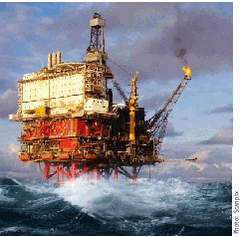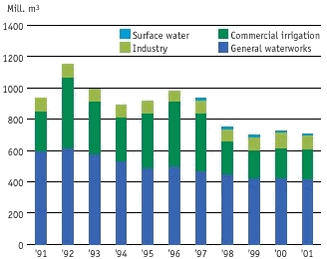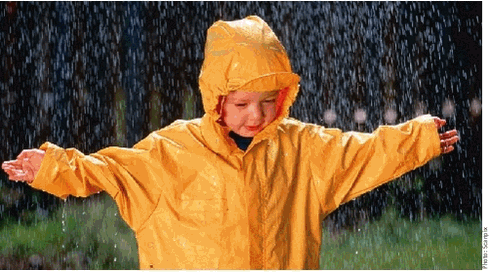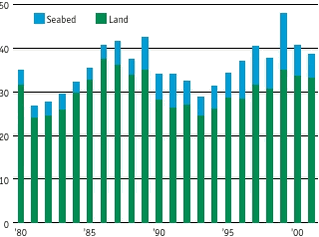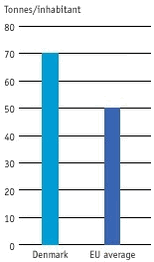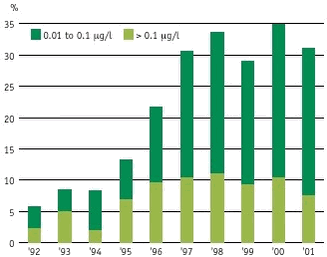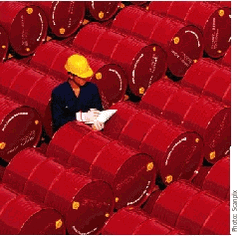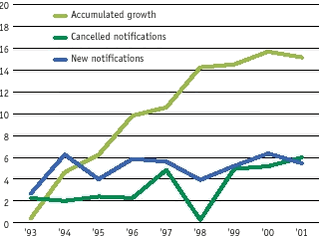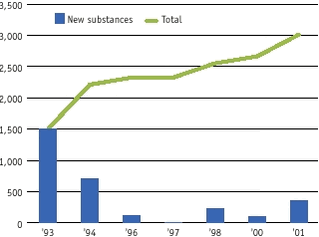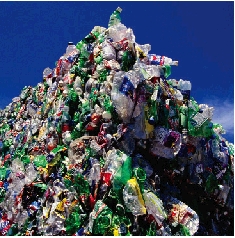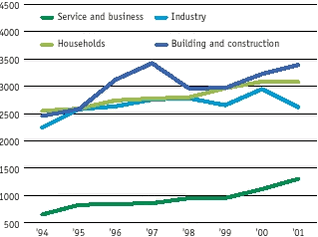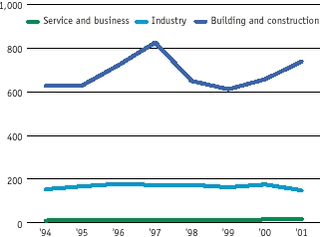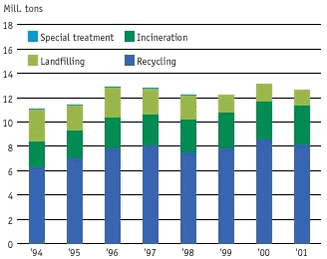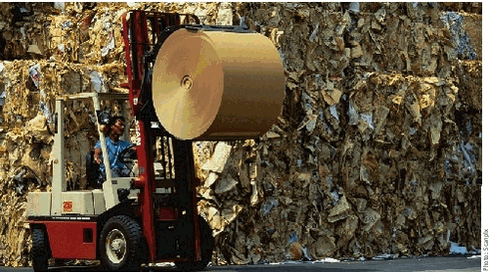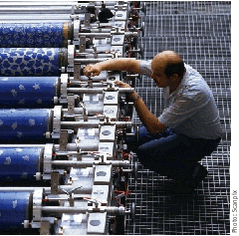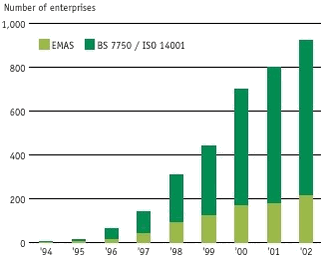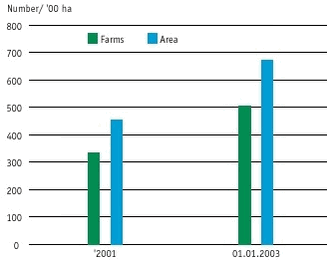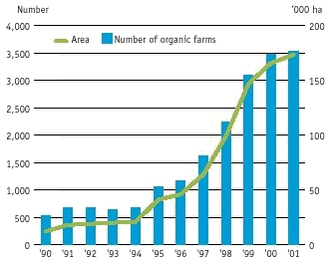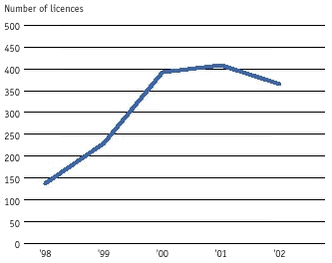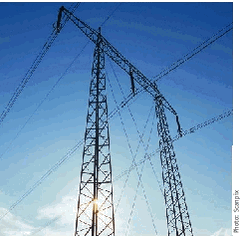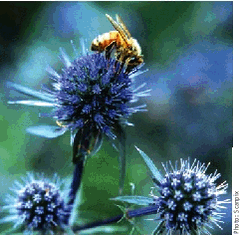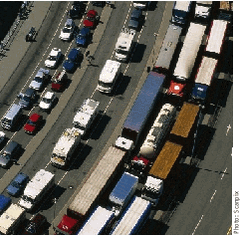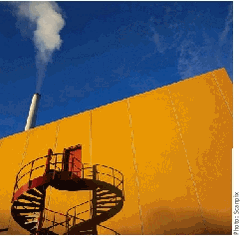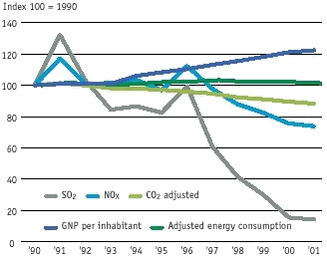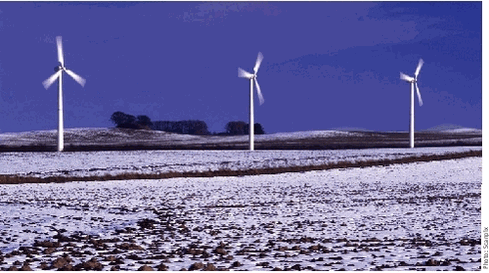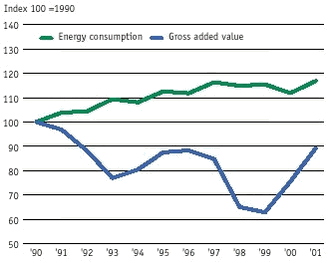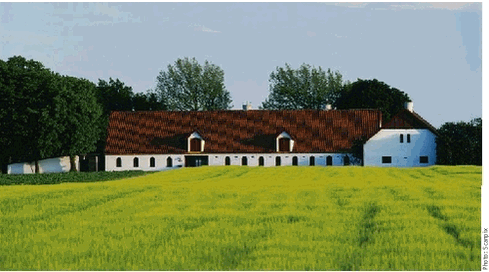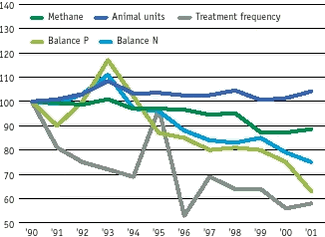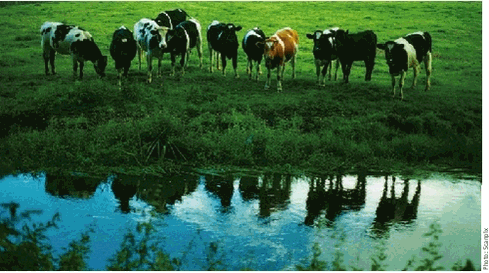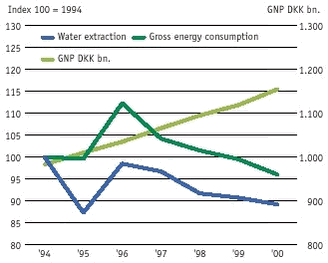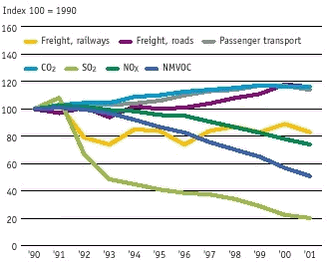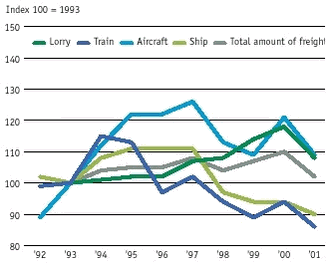Nature and Environment 2002
ProductionResourcesChemicals Waste Environmental management and eco-labelling Environmental impacts by sectors There are more and more people on the earth and they are becoming richer and richer. This means that we produce more and more, and this increases pressures on resources in nature and the environment. Therefore, it is important that our production and consumption is organised so that, in parallel with economic growth, we use fewer resources. We must use less and reuse more. ResourcesThe average Dane uses 70 tonnes of resources each year. This is more than the average EU citizen. In order to use resources sustainably, a long-term objective is to reduce consumption of resources to about one quarter of the current level. Denmark imports coal, minerals, fertilisers, and a large number of raw materials from other countries. Danish forests provide Denmark with timber, and about two-thirds of the area of Den-mark produces food. The Danish underground provides water, oil, natural gas, sand, and gravel. Each Dane uses about 70 tonnes of materials per year, on average. They use these resources when they produce goods, build houses, eat, travel, and for heating. Natural resources are the foundation of welfare and well-being.
Sustainable exploitation If resources are to be exploited sustainably, they must not be destroyed by pollution. Renewable resources must be able to regenerate themselves, and those that do not regenerate themselves must be used sparingly. Soil and water must not be polluted for example. Forest trees must not be felled quicker than they can grow. Raw materials from the underground must be exploited more efficiently. In future there will be more people on the earth. We also expect to be richer, both in the industrialised countries, and in developing countries. In order to use resources sustainably, therefore, the long-term objective is to cut consumption of resources to about one-quarter of the current level. Water consumption is falling During the past ten years, Danish consumption of groundwater has fallen by 40 per cent. However, around Copenhagen Danes are still using so much water that the groundwater cannot re-establish itself quicker than it is being pumped up. It is difficult to keep pollution out of the groundwater. In 2001 pesticides or material from degraded pesticides were found in 30 per cent of the waterworks boreholes investigated. Healthier forests Danish forests have become healthier. In 2001 and 2002 average needle and leaf loss, and the number of damaged trees was the lowest since monitoring the health of forests began in 1989. This means that forests are producing more trees. Total consumption of materials The TMR (Total Material Requirement) indicator expresses the size of the pressure on resources caused by a country’s economy, both within and outside the country’s borders. At 70 tonnes per year, Danes have the same material requirement as Germans and the Dutch, but the requirement is larger than for the average EU citizen, who makes do with 50 tonnes per year.
1 W A T E R E X T R A C T I O N Over the past ten years, water consumption has fallen by 40 per cent, partly because of green taxes. The graph shows the total water extraction and a breakdown between general waterworks, commercial irrigation, industry, and surface water. Source: the Geological Survey of Denmark and Greenland, GEUS
This indicator shows the amount of the groundwater extracted in Denmark each year since 1989. Total water recovered is broken down into four main types: general waterworks (ie. waterworks supplying at least ten properties), commercial irrigation, industry, and surface water. Over the past ten years, total consumption of the groundwater has fallen by almost 40 per cent. In 2001, 707 million cubic metres groundwater was extracted. Of this, 411 million cubic metres were used as drinking water. This continues an almost constant reduction in private consumption since 1989. 99 per cent of Danish drinking water comes from the groundwater, the rest from surface water. The groundwater reproduces itself, but in densely populated areas such as Copen-hagen, Denmark uses the groundwater faster than it can recover. This means boring deeper into the earth to find ground-water – the groundwater level is sinking. There is less water in streams and rivers, and in some cases they run dry in the summer. This happens in eastern Zealand, for example. New studies of groundwater resources indicate that groundwater resources are very scarce, especially on Zealand and the islands, and there is a clear over-exploitation of the resource in these areas. There will be clear environmental and nature benefits in reducing this over-exploitation, as this will result in more groundwater flowing into the dry lakes and streams. The goal(1) remains, therefore, to reduce total extraction of groundwater, including water supply to households. The EU Water Framework Directive states that Denmark must include a number of new environmental goals for the groundwater in Danish legislation. The entire water cycle must be taken into account when wording the new legislation. For example, extraction of ground-water must not be so large that environmental goals for the surface water in lakes and watercourses cannot be kept.
2 S A N D, S T O N E, A N D G R A V E L Denmark extracts sand, gravel, stone, and other raw materials from the underground on land and at sea. The graph shows the amounts extracted from 1980-2000. Source: Statistics Denmark and the Geological Survey of Denmark and Greenland, GEUS Mill. m3
On land, Denmark digs for quartz sand, granite, clay, moler, expanded clay, chalk, limestone, peat, and other raw materials, and at sea Denmark digs for pebble gravel, filling stone, sea gravel, etc. There is a lot of sand, gravel, stone, chalk, and clay in the Danish underground, but the resource is not renewed. Therefore, it is sensible to recycle building waste and residues from power stations in order to reduce consumption of these raw materials. Typically, recycling reduces the annual consumption of virgin raw materials by about 6-7 per cent. At about 33 million m3, extraction from land in 2001 was slightly less than the year before. Extraction from the sea was 5.4 million m3, a drop of about 20 per cent compared with the previous year. The dramatic fluctuation in extraction from the sea reflects the timing of larger construction projects.
3 T H E T O T A L M A T E R I A L R E Q U I R E M E N T Danish citizens use 70 tonnes resources per inhabitant each year. The figure shows the Danish total material requirement for 1997. The indicator has not been calculated for later years. Source: Statistics Denmark
This indicator illustrates the pressure from a single citizen in a country on resources throughout the world. The indicator includes the pressure on resources caused by a country’s economy both within and outside the country’s borders. The indicator does not describe anything about the environmental impacts from this pressure on resources. The Total Material Requirement for Denmark has been calculated at 70 tonnes per inhabitant. This figure is based on data from 1997, and it is the first preliminary estimate of an indicator for the total Danish pressure on domestic and foreign resources. The Danish Total Material Requirement is significantly more than the EU average of 50 tonnes per inhabitant. The Danish pressure on resources is similar to Germany and the Netherlands. A country like Japan uses fewer resources. One of the reasons for the large Danish requirement is the large import of coal and consumption of highly specialised electronic equipment containing substances requiring large amounts of raw materials. For example, large amounts of ore are required to manufacture metals. There are no historical data to show the development in Danish Total Material Requirement. A drop in the Total Material Requirement at the same time as economic growth is a good signal that a country is able to exploit resources more efficiently. From trees to environmental desirable energy A large number of forest trees are used for firewood and woodchips. Woodchips are used by district heating plants and power stations. Consumption of firewood and woodchips has risen in recent years. This is because Denmark is committed to reducing emissios into the air of CO2 (carbon dioxide) in order to reduce the greenhouse effect that may make the climate warmer. Burning wood instead of coal, oil, or natural gas reduces CO2 emissions into the atmosphere. Consumption of firewood produced by forests was about 450,000 cubic metres of wood, replacing about 100,000 tonnes oil. This consumption has remained constant over the past ten years. Consumption of woodchips has increased from 250,000 cubic metres in 2001 to 550,000 cubic metres in 2003. 550,000 cubic metres replace about 25,000 tonnes oil. Source: Danish Forest and Landscape Research Institute
4 F I N D S O F P E S T I C I D E S I N T H E G R O U N D W A T E R Pesticides and products from degraded pesticides have been found on one-third of the water boreholes analysed. The graph shows pesticides found in boreholes at waterworks used for drinking water. Source: the Geological Survey of Denmark and Greenland, GEUS
This indicator shows the proportion of boreholes at waterworks where pesticides have been found. The approximately 3,000 waterworks in Denmark analyse water from extraction boreholes for a large number of substances, including pesticides. The graph includes active boreholes where groundwater has been extracted from 1998-2001. The water is sent to users after aeration, filtering, and mixing with water from other boreholes. Waterworks must be able to supply water with a content of an individual pesticide or degradation product of 0.1 micrograms per litre or less, and a total content of substances of less than 0.5 micro-grams per litre. Boreholes with too high concentrations of pesticides or degradation products are closed, or the water is mixed with water from other boreholes so that the content in the drinking water does not exceed the limit values. There is no complete analysis of the number of water boreholes that have been closed because they are polluted. However, the results clearly indicate that in recent years at least 50 to 100 boreholes have been closed because of one type of pollution or another. The graph also shows that pesticides are the most common cause of closure due to pollution, and that the number of boreholes closed because of pesticide pollution probably will increase in the future. From 1994 to the present, pesticides and degradation products have been found in an increasing number of boreholes. This is primarily because water is tested for more and more substances from year to year. In 2001, pesticides and products from degraded pesticides were found in about 30 per cent of the boreholes examined, and the limit value for drinking water of 0.1 micro-grams per litre was exceeded in 7.5 per cent of boreholes. The goal is for Denmark to continue to be able to use untreated groundwater as drinking water. In principle, therefore, there must be no pesticide residues or degradation products in the groundwater exceeding the limit value of 0.1 micrograms per litre. In recent years, therefore, a large number of the pesticides that can leach down to the groundwater have been banned. However, this does not solve the problem of the pesticide residues already in the soil and on the way down to the groundwater. If the limit value of 0.1 micro-grams per litre in drinking water cannot be met using untreated groundwater, this will mean that waterworks will have to introduce advanced water treatment systems. Pesticides and their degradation products have been found most often in high-lying ground-water aquifers. Pesticides were found in more than 60 per cent of the boreholes extracting water from 0-10 metres below ground level in 2001. Even at a depth of about 30 metres, pesticides were found in about 40 per cent of the boreholes. Larger waterworks typically recover groundwater from greater depths, where pesticides have been found in less than 20 per cent of boreholes. Forests relieve the aquatic environment Groundwater and surface water from forests is significantly cleaner than water from agricultural soil. This is because there are always plants in forests that can absorb nutrients, and because the soil is only rarely tilled. More or less no fertilisers are used in forests, and only a small amount of pesticides. Fewer nutrients Less than 5 kg nitrogen is runoff annually per hectare of forest. In 2001, 76 kg nitrogen was run off on ave- rage per hectare of agricultural soil. However, leaching is considerable from 10 per cent of the forest area, and the concentration of nitrogen in the form of nitrate is more than the limit for drinking water of 50 mg/l. This is either due to air pollution with nitrogen in ammonia, for example, from agriculture, or due to clearing and planting forests that for a period of 3-5 years gives rise to increased leaching of nitrate. Fewer pesticides Pesticide use in forests is dropping. Use is limited to planting, Christmas trees, and decorative greenery. Treatment frequency for agriculture is about 2.1 per year, while for forestry it is less than 0.05. However, the treatment frequency for Christmas trees, that cover 5 per cent of the forest area, is the same as for agri- culture. The consumption of pesticides in state-owned areas fell from 4,000 kg to 800 kg active substances from 1994 to 2000. Evaporation Evaporation of water is greater in forests than in the open landscape. Therefore, formation of groundwater can be less under forests than under agricultural land. Coniferous forests in particular allow for less ground-water formation. On the other hand, the water cycle on agricultural land is much more influenced by draining than in forests. Therefore, planting forests on previously drained agricultural land can, once the drainage has been blocked, mean more formation of groundwater in the long term. Acidification Air pollution can increase acidification of forest soil and the water under the forest. Watercourses in coniferous forests are particularly affected, and this reduces biological diversity in these watercourses. On certain sandy soils, natural acidification and air pollution cause a risk of exceeding the limit values for aluminium and cadmium in the groundwater. Increased forest area The forest area will be increased so that forest landscape covers 20-25 per cent of the area of Denmark within one tree generation (80-100 years). Planting forests on land previously used by agriculture (afforestation) will help protect water resources. Similarly the goal is to ensure that the primary function of 10 per cent of the total forest area is nature and biological diversity. In the 1990s, on average 1,700 hectares of forest were planted each year. In 2000, 3,000 hectares of forest were planted. Source: Danish Forest and Landscape Research Institute ChemicalsWe use thousands of different types of chemicals. Some of them can harm the environment and make us ill. We often do not know about the effects of the substances, but more and more substances are being assessed and regulated. There are chemical substances in more or less all of the products around us, for example in textiles, shoes, cleaning agents, office equipment, furniture, electrical appliances, and toys. In 1990, it was estimated that there were about 20,000 chemical substances on the Danish market. These substances are used in chemical products. Chemical products are mixtures of chemical substances used in goods such as electrical appliances. In the early 1980s 100,000 chemical substances were registered on the European market in the EU list of existing substances, the so-called EINECS list. Many of these substances are harmless, but some can harm the environment or make people ill. Precisely which substances is unknown, because only a minority of the substances has been examined for harmful effects. Use of dangerous substances must be limited One goal in Denmark is that products must not harm the environment or people, neither when they are manufactured, used, or disposed of. This appears in the Danish government’s strategy for sustainable development (2) and in the government’s strategy for the environment and health (3). Consumption of dangerous chemicals must be limited as far as possible, and from 2020 the must be no products or goods on the market containing chemicals with especially problematic health or environmental impacts. Chemicals are more or less regulated by total harmonisation in the EU. The Danish rules are therefore often tied to international regulations, agreements, or cooperation. Up to now, within the EU it has been the task of Member States to examine and assess chemical substances, but this work is very demanding, and knowledge on the content and properties of substances is not always available for the authorities. Therefore, in 2003 the European Commission will present a proposal for new chemicals regulations that will call for industry itself to examine and assess chemical substances. Assessment of chemical substances With the aid of computer models, the Danish EPA has assessed almost one-half of the 100,000 chemical substances for dangerous properties. 21,000 of the substances have been assessed to have dangerous or harmful effects.
However, the computer calculations cannot determine precisely how dangerous the substances are. Therefore the substances have been put in an advisory list for self-classification of dangerous substances, and industry is being encouraged to carry out closer assessment itself, a so-called classification of the substances.
5 C H E M I C A L P R O D U C T S Around 15,000 more products have been registered since 1993 on the Danish Product Register. The blue curve shows the number of new notifications of products for the relevant year. The dark-green curve shows the products that have been withdrawn and cancelled. Growth is shown by the light-green curve. A total of 33,000 products with dangerous properties have been registered. Source: Danish EPA Number in ’000s
This indicator shows new notifications of chemical products on the Danish market, products withdrawn, and the accumulated growth in the number of chemical products in Denmark. The Product Register is a common register, established by the Danish Working Environment Authority and the Danish EPA. The Register contains information about the chemical substances and products used commercially. Some products for consumers are also included. In recent years in Denmark 4,000-6,000 new chemical products have been notified to the Product Register each year, while others have been withdrawn. More than 15,000 more products have been entered on the Register since 1993. A total of 33,000 chemical products have been registered because of their content of dangerous substances. These products contain almost 12,000 different chemical substances. Of the products notified, about 12,600 have been labelled as flammable, 12,400 as dangerous to health, and almost 600 as dangerous to the environment. The rules about labelling products for danger to the environment entered into force in 2002, therefore the number of labels is expected to rise in the future.
6 D A N G E R O U S S U B S T A N C E S The EU has classified 3015 chemical substances and substance groups as dangerous. The figure shows the number of dangerous chemicals that have been classified. Source: Danish EPA Number of substances/substance groups
This indicator shows the number of substances and groups of substances that have been classified as dangerous by the EU since 1993. Classification considers the possible effects of a substance on people and the environment, for example if it is carcinogenic. Classification is an integral part of the overall work to assess and regulate chemical substances. Common EU classification creates a basis for common risk management, including banning sales of carcinogenic or mutanogenic substances, or substances and products that can harm the foetus. The figure does not include substances that are self-classified substances by the producer. The number of classified substances and related substances has doubled since 1993. The EU has classified 3,015 chemical substances and groups of substances as dangerous. If a substance is dangerous, products containing the substance must be labelled with a warning and instructions for safe use. The number of finalised classifications increases in steps, as a large number of classifications are completed at the same time. The work is ongoing. The increasing number of common classifications creates a basis for common risk management and underpins the goal to limit the use of chemicals, and, where relevant, to ban chemicals with harmful effects on people, animals, and nature. Examining chemicals for harmful effects In the early 1980s about 100,000 chemical substances had been registered by the EU, and only a minority had been examined for harmful effects. Using computer models, the Danish EPA has assessed 47,000 of the substances on the EU list. Substances have been assessed for:
The result of the assessments is that 21,000 substances have one or more dangerous properties. The substances have now been listed in the advisory list for self-classification of dangerous substances (“Vejledende liste til selvklassificering as farlige stof-fer” – only available in Danish). The purpose of the list is to enable the industry to classify the otherwise unclassified substances themselves. WasteWhen we produce and consume more, as a rule we create more waste. Waste is a resource that is being lost. We have become better at exploiting the resources in waste, but we should be better still. If we produce and consume more, as a rule we will throw more away. Up to 1997, the quantity of waste in Denmark rose every year. Waste has resources that are being lost, and waste contains environmentally harmful substances. Avoiding large amounts of waste is therefore the highest priority in waste policy. Waste that cannot be avoided must be recycled as much as possible. The rest must be incinerated as much as possible so that the energy in the waste can be used. Finally, the rest that can neither be recycled nor incinerated must be landfilled, and this should be as little as possible. A drop in the amount of waste at the same time as economic growth is a positive signal that we are able to exploit resources more effectively. Less waste From 1997 to 1999 the amount of waste fell despite economic growth. This is especially because the construction sector was able to limit its waste production. From 1999 to 2000, the amount of waste increased again. Since then there has been a slight fall, with different trends in different sectors. Households are fairly constant. There are increasing quantities from the service sector and construction, while quantities from industry are falling. Better exploitation of waste In 1997 a ban was introduced on landfilling waste suitable for incineration. This moved waste from landfills to incineration plants. Tax must be paid on waste for landfilling and incineration, and the tax is higher for landfilling. This has helped Denmark become better at exploiting the resources in waste. More waste is being recycled, more is being incinerated, and less waste is being landfilled. There is still a need to exploit the resources in waste better and reduce the problems of environmentally harmful substances through better waste treatment.
7 W A S T E P R O D U C T I O N The amount of waste increased every year up to 1997. Since then, the construction sector and industry saw a period of falling waste amounts. The graph shows the amounts of waste from households, service and business, industry, and building and construction. Source: Danish EPA ’000 tonnes
Amounts of waste increased for all sectors up to 1997. After this there was a fall in waste quantities from building and construction, and industry until the end of the 1990s, after which amounts rose again. The amounts of waste from households have stabilised in 2003 at 3,083,000 tonnes. This is the same level as for 2000. From 2000 to 2001, the amounts rose for the service sector and for building and construction by 17 per cent and 5 per cent respectively, while industry experienced a fall of 17 per cent.
8 W A S T E A M O U N T S I N R E L A T I O N T O E C O N O M I C G R O W T H Every time industry produces goods worth one million Danish crowns, about 18 tonnes of waste are created. The amount of waste in relation to economic activity is rather stable for industry, and the service and business sectors. The amount of waste fluctuates more for the building and construction sector. The graph shows the amounts of waste from the service and business, industry, and building and construction sectors stated in relation to economic growth in the sectors. Source: Danish EPA and Statistics Denmark 100 kg/DKK mill.
This indicator illustrates the relationship between quantities of waste and economic growth (gross added value), ie. the intensity of waste. The falling curve means that there has been a decoupling between economic growth and waste amounts. In the building sector there was a drop in waste intensity from 1997-1999. In this period it was possible to build more without producing correspondingly increased amounts of waste. Waste intensity fell in the industrial sector from 2000 to 2001. Apart from this it has not been possible to decouple waste production in the individual sectors from economic activity.
9 W A S T E T R E A T M E N T Denmark is landfilling less and incinerating and recycling more. The graph shows waste treatment analysed between landfilling, incineration, and recycling. Source: Danish EPA and Statistics Denmark
This indicator shows the changes in waste and how waste is treated. Up to 1997, the amount of waste in Denmark increased each year. From 1997 to 1999 the total amount of waste fell, despite economic growth. This is especially because it was possible for the building sector to limit waste production. From 1999 to 2000, waste quantities increased again, after which there has been a slight drop. Danish waste treatment is based on the waste hierarchy where prevention has the highest priority, then recycling, followed by incineration for energy and finally landfilling. In 2001 63 percentage points of waste, corresponding to 8,101,000 tonnes was recycled. This is 1,927,000 tonnes, or 7 percentage points more than in 1994. In the same period the proportion of waste being incinerated increased slightly, while the proportion being landfilled fell by 14 percentage points. This is primarily due to the higher taxes for landfilling compared with incineration. So, given the national goal of efficient exploitation of resources, Denmark is becoming better at exploiting the resources in waste. This applies for both materials and energy resources. The waste plan 1998-2004, Waste 21, sets goals for waste treatment in 2004. A total of 64 per cent of waste must be recycled, 24 per cent incinerated, and a maximum of 12 per cent landfilled. Environmental management and eco-labellingEnterprises are increasingly competing regarding the environment, and an increasing number of enterprises are introducing environmental management. The number of licences to use eco-labels and organic farming has increased dramatically, although growth is now levelling out. The Danish Government’s strategy “Making markets work for environmental policies – achieving cost-effective solutions”(4) includes a goal that the market should contribute to creating sustainable development. A number of voluntary schemes are making it easier for consumers and enterprises to help in this development. The role of the consumer Consumers are a driving force towards sustainable production and consumption by demanding environmentally friendly products and environmental efforts from enterprises. This requires that consumers have access to credible and manageable information on how enterprises and their products affect the environment. Products carrying eco-labels help to provide consumers with a greater freedom of choice. Environmental management Enterprises can minimise their environmental impacts by introducing environmental management. If the environmental management of an enterprise meets a number of demands, the enterprise can be registered under the EU environmental management scheme, EMAS, or under the global standard ISO 14001. This is a stamp of quality, and it provides credible documentation of an enterprise’s environmental efforts for customers and cooperation partners. The number of enterprises with certified environmental management that meets the requirements of the EMAS or ISO is increasing each year, and the current level is about 860 enterprises. Agriculture can also introduce environmental management, or decide to prepare green accounts. Green accounts disclose the amount of feed, fertiliser, pesticides, etc the farmer adds to his farm, and the number of pigs, amount of corn, etc. he sells. Green accounts highlight agriculture’s use of resources, and can give rise to savings. Eco-labels Enterprises can also decide to label their products with an eco-label. Food can be labelled with the red Danish letter Ø, meaning that the product is organic.
Other products can be labelled with the Nordic eco-label, the Swan, or the EU Flower label. Both these labels show that the product meets a number of environmental requirements, laid down on the basis of an assessment of the environmental impacts of the product throughout its life-cycle from cradle to grave.21 (4) Danish Government (2003): Making markets work for environmental policies – achieving cost-effective solutions
10 E N T E R P R I S E S W I T H E N V I R O N M E N T A L M A N A G E M E N T More and more enterprises are introducing environmental management. The graph shows the number of enterprises in Denmark registered under the EMAS and ISO schemes. Source: Danish EPA Note: ISO 14001 replaced BS 7750 in 1996.
This indicator shows the number of enterprises with environmental management registered under the EMAS scheme, or certified under the ISO standard. The figures are cumulative. A large number of the enterprises under the EMAS scheme are also certified under the ISO 14001 standard. Since 1994 the number of enterprises with environmental management has increased every year. Together with Austria, Ger-many, and Sweden, Denmark has the most EMAS registered enterprises in Europe in relation to the size of the population.
11 G R E E N A C C O U N T I N G I N A G R I C U L T U R E Up to now, about 500 farms have decided to prepare green accounts. The graph shows the number of farms and their total land area, that have received subsidies for green accounts. Source: Ministry of Food, Agriculture and Fisheries, and the Forest and Nature Agency
Green accounts highlight resource consumption by farms. Farms with green accounts cover a total area of 67,253 hectares. Green accounts are expected to mean less consumption of fer-tiliser and pesticides, and given that they cover such a large area, this will help achieve the goals in the plans for the aquatic environment and pesticides.
12 O R G A N I C F A R M I N G The number of organic farms, etc. increased six-fold during the 1990s. The graph shows both the number and the area of organic farms. Source: Ministry of Food, Agriculture and Fisheries, and the Forest and Nature Agency
This indicator shows the number of organic farms. The graph also shows the area being farmed organically, and it is based on the supervision by the Danish Plant Directorate of authorised organic farming. The number of organic farms was more or less stable from 1991 to 1994, and after this it grew considerably up to 1999. From 1999 to 2000 there was a net increase of 367 farms, and in 2001 an increase of 66 farms. The new applicants all have smaller farms and less livestock. Closer analysis also shows that half of the new applicants are plant breeders. Large organic production of corn, seed, and feed is important because, from 2005, organic livestock must be fed exclusively on organic feed. The Danish organic sector is one of the largest in Europe. The government wants to continue development of the organic sector on the basis of consumer demand and common EU rules as an element in sustainable production of food.
13 P R O D U C T S C A R R Y I N G E C O - L A B E L S There are about 360 licences for the Swan and Flower eco-labels. This corresponds to more than 2,500 product brands. The graph shows the changes in the number of licences. Source: Danmarks Miljømærke-sekretariat (Danish Eco-labelling Secretariat)
This indicator shows the development in the number of licences for the two official Danish eco-labels, the Nordic swan, and the EU Flower. The number of environmental licences increased from 1998 to 2000, especially licences for the Swan, which was introduced in 1998. The drop in licences from 2001 to 2002 is due to a drop in Swan licences for printing paper, as the larger producers no longer considered having a licence beneficial. However, there remains an increase for other product groups. Environmental impacts by sectorsIn a number of areas it has been possible for the agricultural, industrial, energy, and transport sectors to decouple environmental impacts from economic growth. However, emissions of greenhouse gases from traffic are growing. As the population grows and incomes increase, we will also want to eat more, travel more, buy more products, and use more energy. If this development is to be sustainable, we must burden the environment less. A computer produced in 2010 must impact the environment less than one from 2003, and the same applies to T-shirts, refrigerators, travelling, and houses. The energy sector The energy sector ensures that we have light and heat in our houses, and that industry can power its production. Energy primarily comes from power stations, powered by coal, oil, or gas. Icineration forms CO2, and this contributes to the greenhouse effect. Incineration also forms NOX and SO2, both of which can have harmful effects on the environment.
Although Denmark has experienced economic growth, total energy consumption has remained constant over the past ten years. In the same period, emissions by the energy sector of the greenhouse gases NOX and SO2 have fallen. The agricultural sector Agriculture produces food for the domestic market and for export. Farmers use energy, and fertilise their fields with animal manure or commercial fertiliser.
Most non-organic farmers also spray their fields against weeds and pests. Nutrients from fertilisers, in particular nitrogen and phosphorus, can harm the environment, if they occur in large amounts. Pesticides are toxic for wild animals and plants, and in some cases they can leach down into the soil and pollute the ground-water. Since 1990, agricultural emissions of nutrients have fallen by 25 per cent. Many pesticides have been banned. Farmers use smaller quantities of pesticides now, and fields are not sprayed as often as they were ten years ago. The industrial sector Industrial enterprises use large amounts of water and energy when they manufacture products. Since 1996, consumption of water and energy by manufacturing has fallen, and at the same time production has increased in step with economic growth. The transport sector Danes are using their cars more and more, and more goods are being transported. Transport burns energy and leads to emissions of CO2, NOX, SOX, and volatile organic compounds (NMVOC). The amount of transport increased by 16-17 per cent from 1990 to 2000, and energy consumption and emissions of the greenhouse gas CO2 by the sector increased correspondingly. From 1990, all new cars must have a catalytic converter, and this means that emissions of NOX and NMVOC are falling. For all other emissions it has been possible to break the link between growth and environmental impacts by the transport sector.
Environmental considerations by all sectors A goal in the government’s Strategy for Sustainable Development is that consideration for the environment should be part of all sectors. Decoupling between negative environmental impacts and resource consumption from economic activity has taken place in the energy, agricultural, and manufacturing sectors. Decoupling for a number of emissions has also taken place in the transport sector, but emissions of greenhouse gases by the sector are increasing.
Work is also taking place in the EU to integrate environmental considerations into the development of sectors. This happens in the so-called Cardiff Process. The Cardiff Process means that all sectors are responsible for integrating environmental considerations into their policy areas, and for developing strategies and indicators to achieve sustainable development. 14 T H E E N V I R O N M E N T A L P R O F I L E O F T H E E N E R G Y S E C T O RDespite economic growth, Danish energy consumption has remained constant and emissions of pollutants from the energy sector have been falling. The graph shows energy consumption, GNP, and emissions of NOX, CO2, and SO2. Source: National Environmental Research Institute, Energistati-stik, and Statistics Denmark. Note. Energy consumption is calculated in fossil fuel equivalents, and adjusted for imports, exports, and temperature fluctuations. CO2 emissions are calculated on the basis of energy consumption. The gross national product is calculated at prices for the year in DKK billion.
The energy sector emits almost exclusively the greenhouse gas CO2, and it accounts for more than 45 per cent of total Danish emissions of greenhouse gases. Overall, energy use accounts for almost 80 per cent of Danish emissions of greenhouse gases. The sector is also responsible for the most important emissions of acidification substances such as SO2. Since 1990, energy consumption has only grown marginally, even though in the same period Denmark experienced economic growth. Energy is being exploited increasingly efficiently. CO2 emissions fell by about 12 per cent from 1990 to 2001. This is partly because Denmark uses more natural gas and renewable energy. Increasing use of CHP (combined heat and power) has also reduced CO2 emissions. Danish emissions of all greenhouse gases (including CO2) must be reduced so that the average annual emissions for 2008-2012 are 21 per cent less than in 1990.
Emissions of SO2 fell by more than 80 per cent from 1990 to 2001. This is because of flue-gas cleaning, less sulphur in fuels, and more use of natural gas and renewable energy. Denmark was committed to reducing SO2 emissions by 80 per cent from 1980 to 2000. This goal was achieved in 1998. NOx emissions fell by about 25 per cent during the period. This is because of catalytic converters in cars, cleaning at power stations, and more use of natural gas and renewable energy. It is expected that Denmark will be able to meet its goal of reducing emissions of NOx by 47 per cent, compared with 1998, before 2010. This corresponds to 127,000 tonnes.
15 T H E E N V I R O N M E N T A L I M P A C T S O F A G R I C U L T U R E In the early 1990s, energy consumption by agriculture increased at the same time as gross added value fell. In recent years, added value has grown more than energy consumption. The graph shows energy consumption and gross added value for agriculture. Source: National Environmental Research Institute and Statistics Denmark Note. Gross added value is calculated at basis prices, ie. GNP less proportional indirect taxes (such as VAT, consumer taxes, etc.) and proportional subsidies. Proportional taxes are defined as those representing a fixed proportion of the amount or value of a good or service. Gross added value can be calculated by sector, whereas GNP is calculated in total for the country.
Agriculture is emitting less of the nutrients nitrogen (N) and phosphorus (P) into the environment and the number of times fields are sprayed (treatment frequency) has fallen since 1990. From 1990 to 1999 the gross added value of agriculture also fell, but since then it has recovered. Energy consumption increased in the first half of the 1990s, and since then it has been quite stable. Since 1999 the increase in gross added value has been greater than the increase in energy consumption. Farmers add nutrients to the soil in livestock manure or commercial fertilisers, and they remove nutrients in the crops or livestock they sell. If a farmer adds more than he removes, the surplus accumulates in the soil or is spread throughout the environment. In 1990, the nitrogen surplus from Danish agriculture was 480,000 tonnes, and the surplus of phosphorus was 52,000 tonnes. Up to 2001, the surplus of nitrogen fell by about 120,000 tonnes, or about 25 per cent. The surplus of phosphorus fell by about 20,000 tonnes, or 29 per cent in the same period. This development is primarily due to less consumption of commercial fertilisers. Initiatives in the Action Plans for the Aquatic Environment and in the Action Plan for Sustainable Agriculture of 1991 have made it possible to use especially nitrogen better, so that the use of commercial fer-tilisers could be reduced without a corresponding loss of production. The goal of the Action Plan for the Aquatic Environment II is to reduce annual runoff of nitrogen from Danish agriculture by 100,000 tonnes in 2003, compared to the 1987 level of 220,000 tonnes. In January 2001 it was calculated that the initiatives taken so far will reduce annual runoff into streams, lakes, and the sea by 92,600 tonnes in 2003. So, runoff must be reduced by a further 7,400 tonnes. Preparations for the Action Plan for the Aquatic Environment III have therefore commenced, and political negotiations will start after the final assessment of the Action Plan for the Aquatic Environment II. Agriculture emits less nitrogen into the environment and the number of times a field is sprayed has fallen. The graph shows the environmental impacts of agriculture as methane emissions, number of animal units, pesticide treatment frequency, and the balance of nitrogen and phosphorus. Source: National Environmental Research Institute and Statistics Denmark Note. The figure shows indexed values in relation to index 100 for 1990. The Balance P and N 1989/90 is index 100. From 1999, the calculation of animal units is based on the new standard figures for cattle. Index 100 = 1990
Treatment frequency is the number of times each year non-organic fields are sprayed with pesticides. The number is calculated as a national average on the basis of the pesticides sold for the year. Treatment frequency fell from 3.6 in 1990 to 2.1 in 2001. The Action Plan for Pesticides II from 2000 includes a goal that treatment frequency on an individual area should be reduced as far as possible. At first the goal is to reduce treatment frequency to 2.0 by the end of 2002. This goal was already close to being met at the end of 2001. The consumption of pesticides has fallen even more that the treatment frequency. This is linked to the fact that the pesticides now being used are effective at much lower doses. The Action Plan for Pesticides II also contains goals to establish spray-free field margin strips of 50,000 hectares around watercourses and lakes. At the end of 2002, the goal was that the scheme should cover 20,000 hectares. There are more pigs and fewer cows in Denmark. The number of animals is calculated in animal units. An animal unit is the number of animals required to produce 100 kg nitrogen in manure per year. In 1991 there were about 950,000 animal units pigs and 1,280,000 animal units cattle in Denmark. Ten years later there were 32 per cent more pigs and 10 per cent fewer cattle. The total number of animal units increased by about 8 per cent during the period.
16 E F F I C I E N C Y O F R E S O U R C E U S E B Y M A N U F A C T U R I N G S E C T O R Growth and the environment go hand in hand. Consumption of energy and water by the manufacturing sector has fallen in relation to gross national product (GNP). Source: Danish EPA
This indicator shows consumption of energy and water by the manufacturing sector in relation to economic growth. After strong growth from 1995-96, consumption of both energy and drinking water fell in relation to gross national product up to 2000. In the same period, gross national product increased. Therefore there has been a relative decoupling of energy consumption and consumption of drinking water from economic growth in the period 1996-2000.
17 T H E E N V I R O N M E N T A L P R O F I L E O F T H E T R A N S P O R T S E C T O R Traffic, and the associated emissions of CO2, is growing, but other emissions of pollutants are falling. The graph shows the environmental profile of the transport sector, illustrated in terms of energy consumption, CO2, SO2, NOx, and NMVOC emissions, as well as freight and passenger transport. Source: National Environmental Research Institute: national emissions statement from NERI Figures for transport index: The Road Directorate website Note. Cars cover emissions from road traffic (calculated on the basis of sales of fuel in Den-mark). Ships include leisure vessels, fishing, and shipping between two Danish ports. Domestic air travel covers both national traffic and traffic to Greenland and the Faeroe Islands.
Cars and other methods of transport emit a number of pollutants into the air. Some are harmful to health, eg. particles, volatile organic compounds (NMVOCs), and carbon monoxide (CO). Some can harm the environment, eg. nitrogen oxides (NOx) and sulphur dioxide (SO2). CO2 is a greenhouse gas and may affect the climate. In Danish towns and cities, traffic is the greatest source of air pollution. Passenger transport increased by about 16 per cent from 1990 to 2001, and freight transport has increased correspondingly. The increase has been primarily in the number of cars, and today cars account for more than 70 per cent of passenger transport. Passenger transport is measured as person kilometres, and freight in tonne kilometres. A person kilometre is when one person is transported one kilometre, or two people are each transported half a kilometre. The transport sector accounts for about 16 per cent of total Danish emissions of greenhouse gases (CO2), and emissions are growing in line with the growth in traffic. Despite increasing traffic, emissions of NOx, NMVOC, and CO are falling. This is due to the 1990 requirement that catalytic converters should be fitted to all new petrol-fuelled cars. In the period 1988 to 1998, the proportion of cars fitted with a catalytic converter rose from zero to more than fifty per cent. Therefore, it has been possible to break the relationship between growth and environmental impacts by the transport sector for all emissions other than CO2. Emissions of NOx, NMVOC, and CO will probably continue to fall until all petrol-fuelled cars have a catalytic converter. New and stricter regulations for different types of vehicles will enter into force in 2005. Forests absorb CO2 Trees absorb CO2 from the air when leaves photo- synthesise. In this way, trees get energy to grow, and carbon (C) is built in to the trees’ root system, trunk, branches, and leaves. When trees are felled, not all the carbon content is absorbed by the forest increment. By deducting annual tree felling, the net forest increment in which carbon is absorbed is obtained. Less CO2 emissions Denmark is committed to reporting annual emissions of CO2 and other greenhouse gases to the UN Climate Convention. There is also focus on emissions of CO2 under the Kyoto Protocol, where Denmark has pledged to reduce emissions of greenhouse gases by 21 per cent by 2012, compared with 1990 levels. Countries can use the possibility of storing carbon in forests. Absorption is divided into two types of forest.
In 2002, CO2 absorbed in afforestation areas amounted to about 0.1 million tonnes, while about 3.5 million tonnes were absorbed in forests older than 1990. This should be compared with Danish emissions from traffic, power stations, etc. of about 60 million tonnes in 2002. Absorption by forests in 2002 was thus about 6 per cent of total emissions. Source: Danish Forest and Landscape Research Institute
18 F R E I G H T T R A N S P O R T More freight is being transported by lorry and less by ship and aircraft. The graph shows freight transport analysed by type of transport. Source: Statistics Denmark
This indicator shows the changes in the amount of freight in tonnes transported in Denmark, analysed by type of transport. The total amount of freight transported remained more or less unchanged in the period 1993-2001, but the amount transported by ship and train fell, while more freight is being transported by lorry. Previous indicators have shown that total freight transport has increased. The total amount of freight has remained the same, as the distance travelled by each tonne of freight has increased. Overall, the development of freight transport is in conflict with the strategy for transport. The strategy encourages freight transport by ship and train, as these types of transport typically represent less environmental impact.
(1) The Aquatic Environment 99 (Vandmiljø-99). Report 1 Danish EPA 1999 (Only available in Danish) (2) A Shared Future – Balanced Development. Denmark‘s National Strategy for Sustainable Development. Danish Government 2002. (3) Environment and health are closely related. Strategy and Action Plan to protect public health against environmental factors. Danish Government 2003 |
